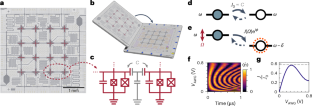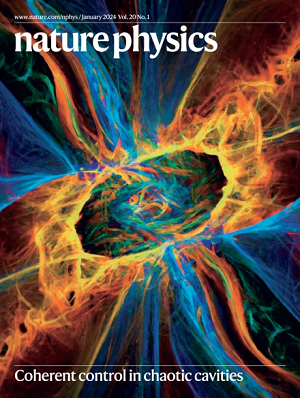二维超导量子比特阵列中的合成磁矢量势
IF 17.6
1区 物理与天体物理
Q1 PHYSICS, MULTIDISCIPLINARY
引用次数: 0
摘要
超导量子处理器因其硬件固有的精确控制、快速运行和定点分辨读取功能,成为模拟量子仿真的理想平台。根据玻色-哈伯德模型,耦合超导量子比特阵列可以模拟相互作用粒子的动力学。然而,许多有趣的凝聚态现象只有在存在电磁场时才会出现。在这里,我们使用超导量子模拟器模拟电磁场中带电粒子的动力学。通过对所有量子比特应用连续调制音调,我们实现了一个广泛可调的合成磁矢量势。我们验证了合成矢量势服从电磁学所需的特性:空间变化的矢量势打破了时间反转对称性并产生了规整不变的合成磁场,而时间变化的矢量势则产生了合成电场。我们证明了霍尔效应--在电磁场中传播的带电粒子的横向偏转--存在于合成电磁场中。本文章由计算机程序翻译,如有差异,请以英文原文为准。


A synthetic magnetic vector potential in a 2D superconducting qubit array
Superconducting quantum processors are a compelling platform for analogue quantum simulation due to the precision control, fast operation and site-resolved readout inherent to the hardware. Arrays of coupled superconducting qubits natively emulate the dynamics of interacting particles according to the Bose–Hubbard model. However, many interesting condensed-matter phenomena emerge only in the presence of electromagnetic fields. Here we emulate the dynamics of charged particles in an electromagnetic field using a superconducting quantum simulator. We realize a broadly adjustable synthetic magnetic vector potential by applying continuous modulation tones to all qubits. We verify that the synthetic vector potential obeys the required properties of electromagnetism: a spatially varying vector potential breaks time-reversal symmetry and generates a gauge-invariant synthetic magnetic field, and a temporally varying vector potential produces a synthetic electric field. We demonstrate that the Hall effect—the transverse deflection of a charged particle propagating in an electromagnetic field—exists in the presence of the synthetic electromagnetic field. Arrays of superconducting transmon qubits can be used to study the Bose–Hubbard model. Synthetic electromagnetic fields have now been added to this analogue quantum simulation platform.
求助全文
通过发布文献求助,成功后即可免费获取论文全文。
去求助
来源期刊

Nature Physics
物理-物理:综合
CiteScore
30.40
自引率
2.00%
发文量
349
审稿时长
4-8 weeks
期刊介绍:
Nature Physics is dedicated to publishing top-tier original research in physics with a fair and rigorous review process. It provides high visibility and access to a broad readership, maintaining high standards in copy editing and production, ensuring rapid publication, and maintaining independence from academic societies and other vested interests.
The journal presents two main research paper formats: Letters and Articles. Alongside primary research, Nature Physics serves as a central source for valuable information within the physics community through Review Articles, News & Views, Research Highlights covering crucial developments across the physics literature, Commentaries, Book Reviews, and Correspondence.
 求助内容:
求助内容: 应助结果提醒方式:
应助结果提醒方式:


